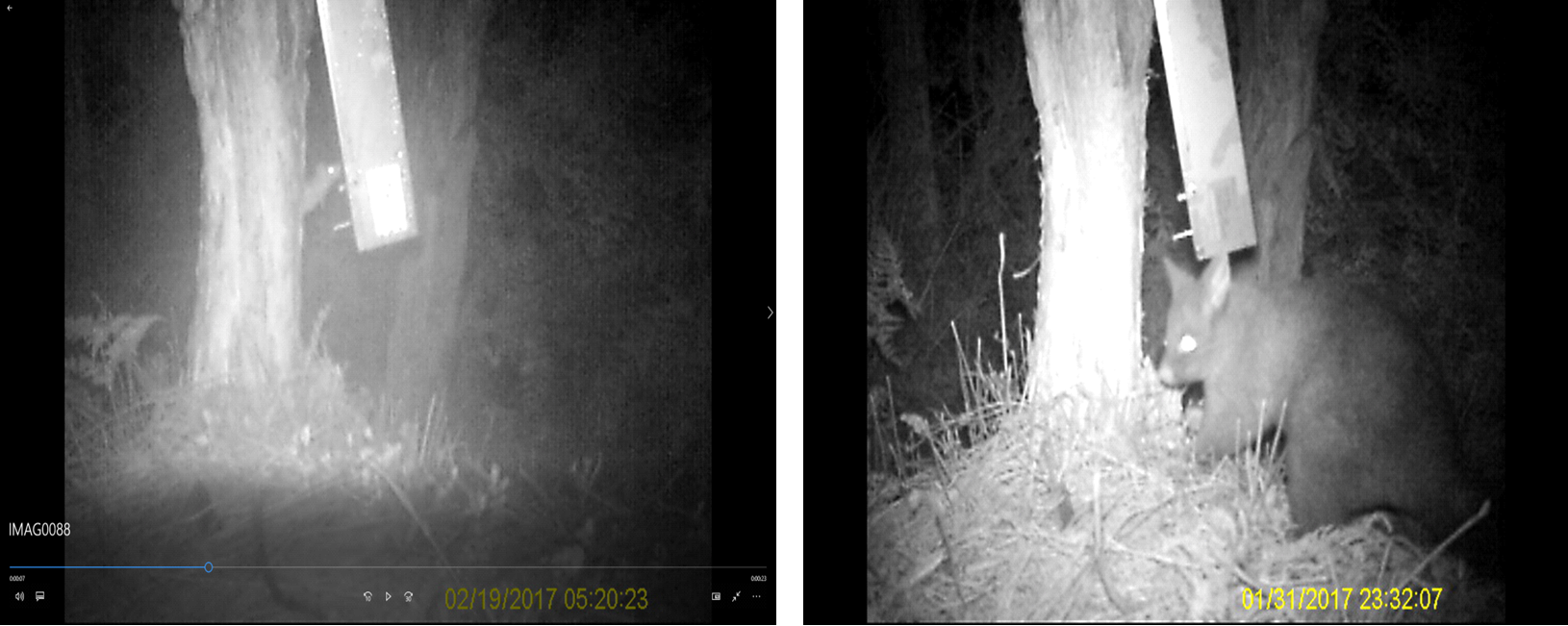If you want to catch a possum, rat or stoat, you need the right lure.
For the past three years, ZIP has been running trials at our Bottle Rock field site in Queen Charlotte Sound, to discover the ultimate possum, rat and stoat lures.
We have learned that possums, with their relatively poor sense of smell, appear to be primarily drawn to novel visual elements in the landscape. The most effective possum lure we have found to date is a small, white square of corflute (the same plastic that real-estate signs are made from). This is great news, because it means that, unlike a food or scent-based lure, the lures on ZIP’s possum traps almost never need to be refreshed.
Unfortunately, the lures we have found to be most attractive to both rats and stoats are fresh foods that typically don't last very long in the field.
Fatty, protein-rich delicacies like Pics peanut butter (which out-performed all other food-based lures tested at Bottle Rock by around 20%), Nutella (another favoured food of rats, particularly during the summer months) and egg mayonnaise (liked by both stoats and rats) quickly succumb to mould or bacterial growth, are eaten by non-target species, or are washed away by rain.
To keep traps attractive and effective, then, these lures typically need to be refreshed by a ranger every 3-4 weeks. This can be a time-consuming (and therefore expensive) task, particularly when working in difficult terrain, which significantly limits the size of an area that can be effectively trapped.
ZIP field ranger refreshing Nutella lure inside a trap box. Photo credit: Media Fix
In an attempt to address this inefficiency (and make life easier for our hard-working rangers), we teamed up with the Christchurch-based mechanical and engineering company inFact in early 2016, to begin development of an automated food lure dispenser capable of holding and dispensing fresh food-based lures in the field for up to a year.
The team at inFact began by looking closely at the properties of a number of ZIP’s top performing food lures, including Pics peanut butter and Nutella, carrying out tests to assess their viscosity, stability, and how they responded to being forced out of a pressurised dispenser.
Of the range of lures tested, Nutella was found to be the most challenging in terms of its viscosity, which varied dramatically when exposed to different temperatures. It made sense, then, to test the prototypes on their ability to reliably dispense Nutella in a range of conditions.
Automated lure dispenser, early prototype with Nutella as the lure. Photo credit: inFact
By April 2016, a number of prototype dispensers were produced, able to extrude consistent, very small volumes (0.15ml) of Nutella at regular, pre-programmed intervals. These early prototypes were complex (see left), and were driven by a set of springs which forced lure out of a syringe in staged increments, when a gearbox and motor drive turned a lead screw, releasing the spring energy.
In early 2017 this design was simplified. The springs and other non-critical components were removed, and the size and weight of the dispenser was reduced. The current design simply uses a drive shaft to screw a syringe plunger each time it is activated. This forces a small amount of the lure from inside the syringe out through the bottom of the dispenser.
The dispenser is designed to put out 0.15 ml of peanut butter, Nutella or mayonnaise (enough to attract target species), every night for a whole year without servicing.
The dispenser can be pre-programmed to dispense the lure at nightly intervals, when rats, stoats and possums are most active (and non-target species like birds are less likely to be around to remove the lure).
The dispenser was trialled at Bottle Rock during 2017, with promising results. Both rats and possums were observed repeatedly visiting it to remove the lure at night. The dispenser worked in the field as intended, and didn’t suffer any damage at the teeth or claws of hungry predators.
Prototype automated lure dispenser (tree-mounted) visited by a rat (left) and a possum (right). Photo credit: ZIP
We are currently in the process of trialling the dispenser at our Perth Valley field site in South Westland. The volatile conditions and challenging terrain of this site make it a perfect environment to really put the dispenser to the test.
Tree-mounted automated lure dispenser, Perth Valley. Photo on right shows dispenser with cover removed.
The lure pictured is Pics peanut butter mixed with Rhodamine B bio-marker. Photo credit: ZIP
In the Perth Valley, the Pics peanut butter we are attempting to dispense appears to be hardening and separating under pressure. The peanut butter has been mixed with Rhodamine B bio-marker for a related trial to assess the effectiveness of the Perth River as a barrier to rat and possum migration, and it’s possible that this has affected the consistency of the lure.
Whatever the cause, this is a previously undiscovered issue, and addressing it will be one of the many things keeping our engineer busy over the next few weeks!
Stay tuned...
Want to learn more?
Check out the technical report.






